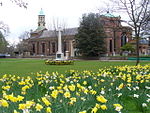Kew Gardens

Kew Gardens is a botanic garden in southwest London that houses the "largest and most diverse botanical and mycological collections in the world". Founded in 1840, from the exotic garden at Kew Park, its living collections include some of the 27,000 taxa curated by Royal Botanic Gardens, Kew, while the herbarium, one of the largest in the world, has over 8.5 million preserved plant and fungal specimens. The library contains more than 750,000 volumes, and the illustrations collection contains more than 175,000 prints and drawings of plants. It is one of London's top tourist attractions and is a World Heritage Site.Kew Gardens, together with the botanic gardens at Wakehurst in Sussex, are managed by the Royal Botanic Gardens, Kew, an internationally important botanical research and education institution that employs over 1,100 staff and is a non-departmental public body sponsored by the Department for Environment, Food and Rural Affairs.The Kew site, which has been dated as formally starting in 1759, although it can be traced back to the exotic garden at Kew Park, formed by Henry, Lord Capell of Tewkesbury, consists of 132 hectares (330 acres) of gardens and botanical glasshouses, four Grade I listed buildings, and 36 Grade II listed structures, all set in an internationally significant landscape. It is listed Grade I on the Register of Historic Parks and Gardens.Kew Gardens has its own police force, Kew Constabulary, which has been in operation since 1845.
Excerpt from the Wikipedia article Kew Gardens (License: CC BY-SA 3.0, Authors, Images).Kew Gardens
Thames Path - northern Bank, London Isleworth (London Borough of Hounslow)
Geographical coordinates (GPS) Address Website External links Nearby Places Show on map
Geographical coordinates (GPS)
| Latitude | Longitude |
|---|---|
| N 51.478888888889 ° | E -0.29361111111111 ° |
Address
Royal Botanic Gardens, Kew
Thames Path - northern Bank
TW8 8HE London, Isleworth (London Borough of Hounslow)
England, United Kingdom
Open on Google Maps










